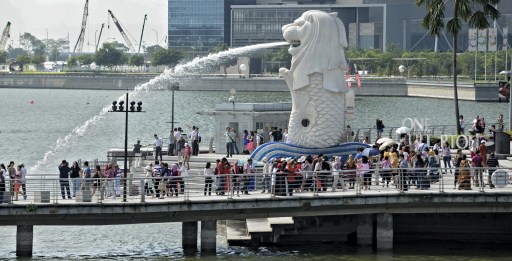
Visitors gather along the pier in front of the iconic sculpture of the Merlion in Singapore. AFP
Singapore’s economic recovery is gathering pace due in part to a sustained increase in global electronics demand, the Monetary Authority of Singapore (MAS) said.
While pockets of weakness remain in some sectors, growth is broadening beyond trade-related industries, with economic expansion expected to remain steady in the coming year, the central bank noted in its latest macroeconomic review out on Friday (Oct. 27).
Official forecasts tip economic growth of 2 percent to 3 per cent this year. The final figure is expected to come in at the upper half of this range, before moderating slightly next year, MAS said.
The central bank struck a noticeably more optimistic note in its latest macroeconomic review, noting that steady growth in the global economy is likely to be sustained in the short term, amid more favorable business sentiment and tightening labour markets in developed economies.
Stronger trade growth in Asia since late last year has also led to a pickup in manufacturing activity and a rise in incomes.
In tandem with this rosier environment, Singapore’s economy has expanded by an average of 4.4 percent quarter on quarter in the second and third quarters – a turnaround from the contraction recorded in the first quarter of the year.
The upswing was led mainly by trade-related sectors, which were in turn boosted by the continued strength in the global electronics cycle.
At the same time, stronger growth has also been accompanied by a broadening of the recovery across more industries.
Some of the strength in electronics production should carry over into next year, but growth is expected to moderate in the quarters ahead, the central bank said.
Meanwhile, industry segments such as financial services and retail are expected to benefit from the improvement in the overall business climate, as well as underlying strength in regional trade and growth.
This means growth should become less patchy across sectors in the coming months, MAS said. Some segments are still strug-gling, however, including marine and offshore engineering as well as construction.
CIMB Private Bank economist Song Seng Wun said the central bank appears more positive about the economic outlook compared with a year ago, back when the world was still reeling from the impact of Brexit and the election of Donald Trump as the US President.
“On the whole, the economy has done better than expected, but we remain cautiously optimistic and mindful of the downside risks.”
Still, there are indications that sentiment is indeed picking up: The job market, for instance, is showing signs of emerging from the doldrums, with a lower overall unemployment rate in the third quarter and no increase in retrenchments, according to Manpower Ministry data on Friday.
“If improvements in the labour market continue, this will be supportive of domestic consumption and further lift growth,” noted MSong.
Economists also pointed out that the rise in private property prices in the third quarter of 0.7 percent, the first in nearly four years, and the recent revival of the collective sale market can also be seen as reflections of a more upbeat sentiment.
But it might be too early to herald the return of a booming property market: The Urban Redevelopment Authority noted in data released yesterday that the redevelopment of collective sale sites will add a significant number of housing units to the existing supply pipeline.